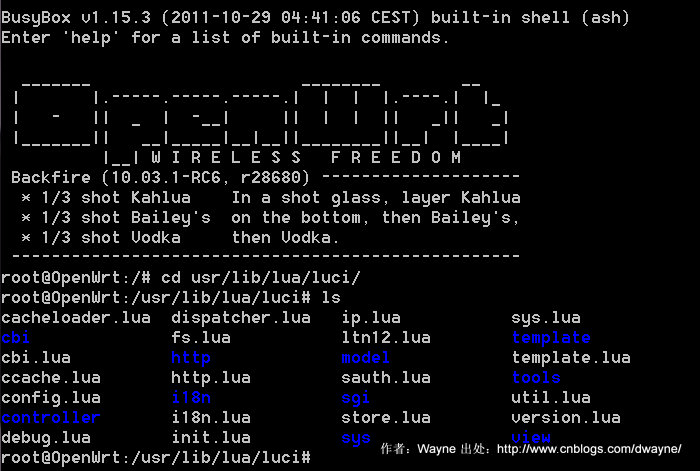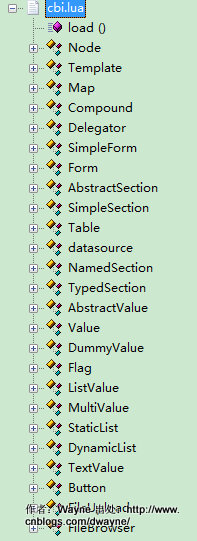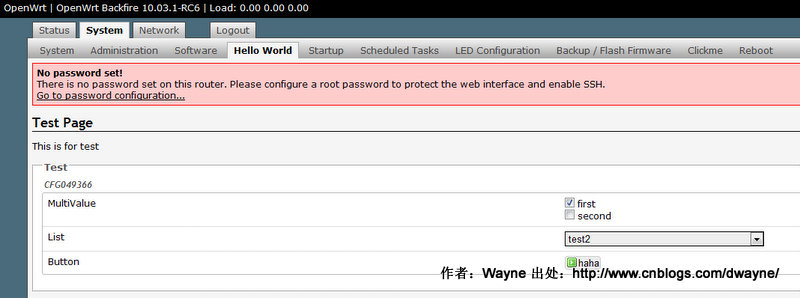初识Lua-OpenWrt路由界面配置
OpenWrt路由的界面配置使用LuCI系统管理。

在此,对其中的目录结构进行介绍:
-目录结构
以status模块为例进行说明,模块入口文件status.lua在目录lua\luci\controller\admin下。
function index()
entry({"admin", "status"}, alias("admin", "status", "overview"), _("Status"), 20).index = true
entry({"admin", "status", "overview"}, template("admin_status/index"), _("Overview"), 1)
entry({"admin", "status", "iptables"}, call("action_iptables"), _("Firewall"), 2).leaf = true
……
entry({"admin", "status", "processes"}, cbi("admin_status/processes"), _("Processes"), 6)
……
end
在index()函数中,使用entry函数来完成每个模块函数的注册,官方说明文档如下:
entry(path, target, title=nil, order=nil)
- path is a table that describes the position in the dispatching tree: For example a path of {"foo", "bar", "baz"} would insert your node in foo.bar.baz.
- target describes the action that will be taken when a user requests the node. There are several predefined ones of which the 3 most important (call, template, cbi) are described later on on this page
- title defines the title that will be visible to the user in the menu (optional)
- order is a number with which nodes on the same level will be sorted in the menu (optional)
其中target主要分为三类:call,template和cbi。
call用来调用函数。
即语句entry({"admin", "status", "iptables"}, call("action_iptables"), _("Firewall"), 2)
Firewall模块调用了action_iptables函数:
function action_iptables()
if luci.http.formvalue("zero") then
……
end
end
template用来调用已有的htm模版,模版目录在lua\luci\view目录下。
即语句entry({"admin", "status", "overview"}, template("admin_status/index"), _("Overview"), 1)
调用了lua\luci\view\admin_status\index.htm文件来显示。
cbi语句使用cbi模块,这是使用非常频繁也非常方便的模块,在cbi模块中定义各种控件,Luci系统会自动执行大部分处理工作。其链接目录在lua\luci\model\cbi下。
显然语句entry({"admin", "status", "processes"}, cbi("admin_status/processes"), _("Processes"), 6)
调用lua\luci\model\cbi\admin_status\processes.lua来实现模块。
这样我们可以发现,cbi模块可能是核心功能模块了,我们看看这个模块的使用。
-cbi模块
cbi模块包含的一系列lua文件构成界面元素的组合,所有cbi模块中的控件都需要写在luci.cbi.Map中。
在cbi.lua文件中封装了所有的控件元素,例如复选框,下拉列表等。

常用控件的具体说明可以参照LuCI Documentation中的描述。
http://luci.subsignal.org/trac/wiki/Documentation/CBI
在此简单地举例Button来说明其应用
button = s:option(Button, "_button", "Button")
button.inputtitle = translate("exec")
button.inputstyle = "apply"
function button.write(self, section, value)
AbstractValue.write(self, section, value)
local listvalue = luci.fs.readfile("/etc/saveValue")
os.execute("touch /etc/testfile%s" %{listvalue})
self.inputtitle = translate("haha")
end
按钮的响应过程为:从saveValue文件中获取内容,然后以获取到的字符串命名创建新文件。
截一张学习测试界面时的图:

Lua语言也是这几天才开始接触,了解必然是有局限性的,wayne欢迎大神们的指导,希望能共同促进!
作者:Wayne
出处:http://www.cnblogs.com/dwayne/
本文版权归作者和博客园共有,欢迎转载,但未经作者同意请保留此段声明,且在文章页面明显位置给出原文链接。


